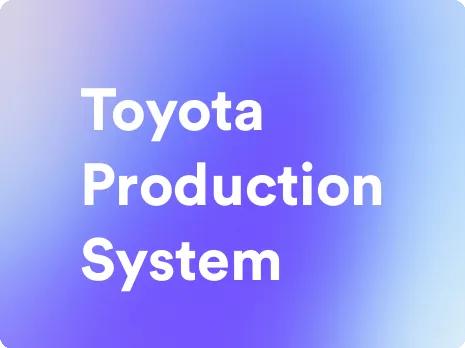Toyota Production System: Maximizing Productivity
This guide will walk you through the essential elements of using toyota production system - the productivity method to keep your team productive and engaged.
Try Lark for Free
The Toyota Production System (TPS) is a manufacturing methodology that aims to boost efficiency, reduce waste, and enhance quality in production processes. This article will delve into the origins, advantages, and implementation of TPS, addressing its target audience, the dos and don'ts, step-by-step guide, FAQs, and concluding remarks.
What is the Toyota Production System in the Context of Productivity?
Revolutionizing Manufacturing Productivity
The Toyota Production System is a renowned approach in the manufacturing industry, characterized by its focus on creating value for customers while eliminating waste within the production process. At its core, TPS integrates the concepts of continuous improvement and respect for people, aligning with the pursuit of increased productivity and overall excellence.
Principles Underlying TPS
At the heart of TPS lie several key principles, including Just-in-Time and Jidoka (autonomation). Just-in-Time emphasizes the delivery of products, parts, or information exactly when needed, while Jidoka concentrates on building a self-regulated process that detects problems to ensure high-quality output. These principles collectively drive operational effectiveness and efficiency, setting TPS apart as an influential force in the realm of manufacturing productivity.
Applying Lean Thinking
TPS is often closely associated with lean manufacturing, which endorses the maximization of customer value while minimizing waste. Through TPS, organizations continuously strive for the elimination of wasteful practices in production, such as overproduction, excess inventory, and defects, fundamentally driving improved productivity.
Origin of Toyota Production System
A Glimpse into Toyota's Roots
The roots of Toyota Production System trace back to the post-World War II era in Japan, where the Toyota Motor Corporation cultivated the approach as a response to the financial constraints of the time. The system's founders, Taiichi Ohno and Sakichi Toyoda, meticulously designed and refined the methodologies, realizing that traditional approaches to manufacturing lacked the requisite flexibility and efficiency.
Evolution Through Continuous Improvement
Over time, TPS underwent substantial evolution through the assimilation of innovative concepts and the emphasis on employee engagement. The pivotal role of Kaizen – the philosophy of continuous improvement – elevated TPS to a comprehensive and sustainable system, laying the groundwork for its widespread adoption across diverse industries globally.
Use Lark to unleash your team productivity.
Who Can Benefit From Toyota Production System?
Relevance Across Industries
The Toyota Production System extends its benefits to a myriad of industries, including automotive manufacturing, healthcare, aerospace, and beyond. Regardless of the sector, organizations striving for enhanced productivity, effective resource utilization, and cost reduction can capitalize on TPS to achieve their objectives.
Prerequisites for Successful Implementation
While TPS is not restricted by industry boundaries, it is vital for organizations to foster a culture of continuous improvement and invest in employee training. A genuine commitment to process optimization, waste reduction, and quality enhancement is fundamental when considering implementation of TPS, ensuring an environment conducive to reaping its benefits.
Pros and Cons of Toyota Production System
Advantages of TPS
- Enhanced Productivity: TPS fosters streamlined operations, thus accelerating productivity and resource utilization.
- Waste Minimization: TPS meticulously targets waste, driving efficiency through the elimination of non-value-adding activities.
- Quality Improvement: The focus on quality control significantly enhances the overall output quality, thereby bolstering customer satisfaction.
Limitations of TPS
- Complex Implementation: Successful implementation of TPS demands diligent planning, significant upfront investment, and comprehensive employee training.
- Cultural Shift Required: Organizations may encounter challenges associated with instigating a cultural transformation to align with the principles of TPS.
Learn more about Lark x Productivity
Getting Started with Toyota Production System
Assessing Organizational Readiness
Embarking on the TPS journey necessitates a thorough assessment of the organization's current operational landscape. Pinpointing areas of improvement, identifying inefficient practices, and gauging the commitment to change are crucial preliminary steps.
Structuring a TPS Implementation Plan
Laying a robust foundation is imperative when diving into TPS implementation. Establishing clear objectives, devising a phased rollout plan, and aligning the organizational structure to accommodate the TPS framework are pivotal to ensuring a successful transition.
Use Lark to unleash your team productivity.
Actionable Tips for Toyota Production System
Do's and Dont's
| Do's | Dont's |
|---|---|
| Invest in comprehensive employee training to instill TPS principles. | Neglect the significance of cultivating a culture of continuous improvement. |
| Foster an environment where employees are encouraged to report inefficiencies. | Underestimate the impact of wasteful practices on overall productivity. |
| Establish clear performance metrics to gauge the effectiveness of TPS implementation. | Overlook the need for periodically reassessing the TPS framework for optimal adaptation. |
Conclusion
With its roots entwined in the pursuit of efficiency and quality, the Toyota Production System stands as an exemplar for organizations striving to optimize their production processes. The multifaceted benefits of TPS, ranging from waste reduction to enhanced agility, position it as an indispensable ally in the quest for sustained productivity.
